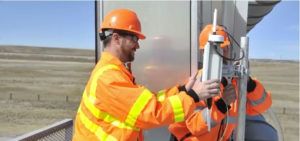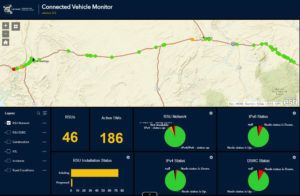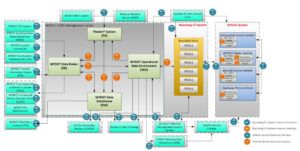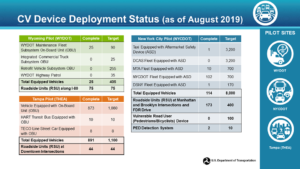The team working on the US Department of Transportation’s (USDOT) Connected Vehicle Pilot Deployment Program in Wyoming have developed open-source applications for the operation and maintenance of Roadside Units (RSUs) that can be viewed by all stakeholders.
The Wyoming Department of Transportation (WYDOT) Connected Vehicle Pilot implementation includes the deployment of 75 RSUs along 400 miles (644km) of I-80. With long drive times and tough winters in the state, WYDOT needed an efficient way to monitor the performance of and manage and update these units to maintain peak performance. With no suitable product readily available, the WYDOT Connected Vehicle team developed an open-source application that allows authorized transportation management center (TMC) operators to monitor and manage each RSU at the roadside. The WYDOT team found that the application can also be used as a public-facing tool that shows a high-level status report of the pilot’s equipment.
The TMC portion of the application is called the Service Monitor Device Management. The application is for use by WYDOT TMC operators only and provides a quick, real-time, single view into RSU status and management. The operators have access to the RSU Internet Protocol addresses and can remotely manage each RSU by performing functions such as:
- Rebooting;
- Checking and updating firmware;
- Viewing active traveler information messages (TIMs);
- Viewing the number of connected vehicles that have driven past in the last 24 hours.
A new National Transportation Communications for Intelligent Transportation Systems Protocol (NTCIP) standard, NTCIP 1218 v01, Object Definitions for RSUs, is currently under development. This standard will define the protocols and Simple Network Management Protocol objects for configuring, operating, and maintaining RSUs from a TMC.
 The Connected Vehicle Monitor (CVM) application is essentially the same data pushed to Connected Vehicle Pilot stakeholders, yet in view-only mode. This component allows users to zoom in and out on a specific segment of I-80. In particular, the tool is valuable to demonstrate how TIMs are being pushed out to the RSUs and how many vehicles are receiving the messages. For example, a stakeholder browsing the CVM can quickly identify what TIMs are being pushed out currently and how many vehicles pass the RSU.
The Connected Vehicle Monitor (CVM) application is essentially the same data pushed to Connected Vehicle Pilot stakeholders, yet in view-only mode. This component allows users to zoom in and out on a specific segment of I-80. In particular, the tool is valuable to demonstrate how TIMs are being pushed out to the RSUs and how many vehicles are receiving the messages. For example, a stakeholder browsing the CVM can quickly identify what TIMs are being pushed out currently and how many vehicles pass the RSU.
The CVM also includes integration with other WYDOT applications for traveler information. The application presents a rolling log of information for the past 24 hours. Information used for the CVM is also being used to create an analytic dashboard that will report on several of the performance measures identified by the Connected Vehicle Pilot. The upcoming dashboard will make use of aspects of the CVM, but present other data to determine overall performance impacts of the pilot.
 For other state or local agencies and departments of transportation (DOTs) wishing to deploy a similar capability to monitor and manage RSUs, the application code has been made available on the USDOT’s Open Source Application Development Portal (OSADP). The code is downloadable and can be used and customized by other agencies free of charge. WYDOT developed this capability using USDOT funds under the CV Pilot program as open-source software and associated documentation. The application represents one of six that the program will be providing during its three phases.
For other state or local agencies and departments of transportation (DOTs) wishing to deploy a similar capability to monitor and manage RSUs, the application code has been made available on the USDOT’s Open Source Application Development Portal (OSADP). The code is downloadable and can be used and customized by other agencies free of charge. WYDOT developed this capability using USDOT funds under the CV Pilot program as open-source software and associated documentation. The application represents one of six that the program will be providing during its three phases.





